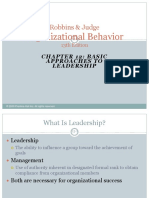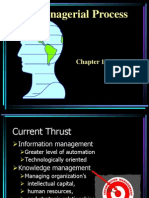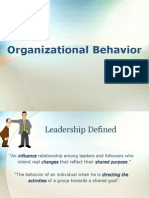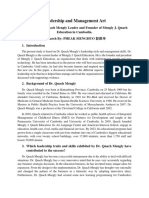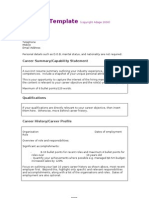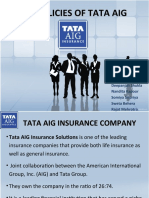0 ratings0% found this document useful (0 votes)
123 viewsIntroduction To HRM
Introduction To HRM
Uploaded by
tchoumbaprincessThe document provides an introduction to human resource management (HRM). It defines key concepts such as human resources, management, and HRM. HRM is described as a process of managing an organization's employees through policies and practices with the aim of attracting, developing, motivating, and retaining personnel to achieve organizational goals. The importance of HRM for managers is discussed, noting how HRM helps avoid issues like hiring mistakes, turnover, and legal problems. Finally, the major functions of HRM are outlined as planning, staffing, organizing, and directing the workforce.
Copyright:
© All Rights Reserved
Available Formats
Download as PDF, TXT or read online from Scribd
Introduction To HRM
Introduction To HRM
Uploaded by
tchoumbaprincess0 ratings0% found this document useful (0 votes)
123 views21 pagesThe document provides an introduction to human resource management (HRM). It defines key concepts such as human resources, management, and HRM. HRM is described as a process of managing an organization's employees through policies and practices with the aim of attracting, developing, motivating, and retaining personnel to achieve organizational goals. The importance of HRM for managers is discussed, noting how HRM helps avoid issues like hiring mistakes, turnover, and legal problems. Finally, the major functions of HRM are outlined as planning, staffing, organizing, and directing the workforce.
Original Description:
NOTES ON HUMAN RESOURCES
Original Title
1. INTRODUCTION TO HRM
Copyright
© © All Rights Reserved
Available Formats
PDF, TXT or read online from Scribd
Share this document
Did you find this document useful?
Is this content inappropriate?
The document provides an introduction to human resource management (HRM). It defines key concepts such as human resources, management, and HRM. HRM is described as a process of managing an organization's employees through policies and practices with the aim of attracting, developing, motivating, and retaining personnel to achieve organizational goals. The importance of HRM for managers is discussed, noting how HRM helps avoid issues like hiring mistakes, turnover, and legal problems. Finally, the major functions of HRM are outlined as planning, staffing, organizing, and directing the workforce.
Copyright:
© All Rights Reserved
Available Formats
Download as PDF, TXT or read online from Scribd
Download as pdf or txt
0 ratings0% found this document useful (0 votes)
123 views21 pagesIntroduction To HRM
Introduction To HRM
Uploaded by
tchoumbaprincessThe document provides an introduction to human resource management (HRM). It defines key concepts such as human resources, management, and HRM. HRM is described as a process of managing an organization's employees through policies and practices with the aim of attracting, developing, motivating, and retaining personnel to achieve organizational goals. The importance of HRM for managers is discussed, noting how HRM helps avoid issues like hiring mistakes, turnover, and legal problems. Finally, the major functions of HRM are outlined as planning, staffing, organizing, and directing the workforce.
Copyright:
© All Rights Reserved
Available Formats
Download as PDF, TXT or read online from Scribd
Download as pdf or txt
You are on page 1of 21
At a glance
Powered by AI
The key takeaways are the definitions and importance of human resource management. HRM deals with managing employees through policies and practices to achieve organizational goals.
The main concepts discussed include the definitions of human resource, management, and human resource management. It also discusses the importance of HRM to managers.
Some of the responsibilities of the HR department discussed include conducting pay surveys, informing managers about changes in employment law, and developing evaluation forms.
HUMAN RESOURCE MANAGEMENT
TOPIC:
INTRODUCTION TO HUMAN RESOURCE MANAGEMENT
BY
DR. NWAHANYE EMMANUEL
SENIOR LECTURER OF MANAGEMENT,
UNIVERSITY OF BUEA
1. CONCEPTS
Human Resource:
Worker or employee or personnel having a potential
contribution to the organization activities and
performances. It is regarded as a significant asset in terms of
skills, competences, capabilities and abilities.
Management:
Harold Koontz defined management as “the process of
designing and maintaining an environment in which
individuals, working together in groups efficiently to
accomplish selected aims”.
It is also defined as “an ongoing process of planning,
organizing, leading, and controlling an organisation’s
human, financial, physical, and information resources to
achieve organisational goals in an efficient and effective
manner”.
Human Resource Management:
Human resource management deals with how to manage employees in the
organisation.
The focus here is on two definition.
According to Decenzo and Robbins, “Human Resource Management is concerned
with the people dimension” in management.
Since every organization is made up of people, acquiring their services, developing
their skills, motivating them to higher levels of performance and ensuring that they
continue to maintain their commitment to the organization is essential to achieve
organsational objectives.
Edwin Flippo defines HRM as a process of planning, organizing, directing, controlling of
procurement, development, compensation, integration, maintenance and separation
of human resources to the end that individual, organizational and social objectives are
achieved.
These definitions globally provide three main issues regarding the definition of HRM:
HRM is a set of policies and practices in favour of employees;
It is a sub-system of the whole management system;
It has as purpose, attracting, mobilizing, developing, motivating, and maintaining
HR, and separating with HR too;
It serves the overall purpose of the organisation (achieving organizational
objectives).
In conclusion
HRM is a process of managing HR of an organisation. In other
words, it is a process of planning, organizing, leading and
controlling the HR of an organization in order to achieve the
organizational goals. Or it can be described as a process on
how employees are managed in an organization. That is done
though policies and practices that are put in place by an
organization in favour of its employees.
Thus, we define HRM as a set of policies and practices an
organisation put in place in favour of its employees with the
aims of attracting, mobilizing, developing, motivating and
maintaining them for the purpose of achieving organizational
goals.
It shows that our focus here is on HR policies and Practices.
2. IMPORTANCE OF HRM TO MANAGERS
The HR Department usually supports managers in carrying out HR responsibilities. It may,
- conduct a pay survey to determine a salary range for a given position,
- inform managers about changes in employment law,
- Develop a form to evaluate employees,
- Determine if applicants meet minimum position requirements.
- Etc.
But at the end, it is managers who determine a prospective employee’s salary subject
to budget constraints, ensure that the law is being applied correctly, assess a
subordinate’s performance, and make final hiring decisions.
For this reason, there is an old saying among HR professionals “Every manager is a
personnel manager”. Every entry-level supervisors play a vital role in HR practices. They
are part of the selection process, and then train, coach, and evaluate employees.
Globally, HRM through policies and practices is of great importance to manager. This
importance is more reflected through an assessment of potential personnel mistakes
that should not be made. A Manager doesn't want to:
Hire the wrong person for the job (helps in hiring the right person).
Experience high turnover (reduces employee turnover or increases employee
retention)
Have employee not doing their best
Waste time with useless interviews
His company to be taken to court because of discriminatory actions
His company cited under occupational safety laws for unsafe practices
Have some employees think their salaries are unfair and inequitable relative to
others in the organisation (equity and fair treatment)
Allow a lack of training to undermine his department's effectiveness
Commit any unfair labor practices
3. FUNCTIONS OF HRM
The functions of HRM are divided into two categories: the managerial functions and the operative
functions.
3.1. Managerial functions of Human Resource Management
a) Planning
In the HRM context, planning comprises of the following:
Establishing goals and objectives to be achieved through the employees so as to achieve the
organizational mission set by the top-level management.
Developing rules and procedures which have to be followed by the employees in order to avoid any
sort of discrimination among employees in any of their functions, to enable fair and transparent
treatment among employees, to avoid conflict starting from recruitment to the separation of
employees, inculcate discipline among the employees, to drive performance of employees and
ultimately to avoid conflict and contravenes with statutes and employment laws of the land,
ultimately for smooth running of the organisation.
Determining plans and forecasting techniques as a part of Human Resource Planning to avoid any
shortfall of workforce so as to avoid impact on the output of the organisation, to draw the estimation
of workforce exactly needed for the organisation and to plan for attracting talented candidates.
HR outsourcing: as that of make or buy decision in operations management, human resource
manager should be able to make decisions with regard to HR activities which are to be executed by
the management itself or to be outsourced when there is advantage of expertise to bring in and cost-
saving for organization. The following are the most outsourced HR activities; legal advice and support,
employee payroll, pensions, training and development, recruitment, employee assistance,
compensation and benefits, outplacement is, human resource information systems, employee
relations, policy-making, strategic partnerships, appraisal of employees and resource planning.
b) Staffing
Staffing is one of the key functions of human resource management as staffing is the
process of employing right people, providing suitable training and placing them in the right
job by paying them accordingly and satisfactorily.
Determining the type of people to be hired;
Recruiting prospective employees and selecting the best ones;
Introducing the new recruits to their working environment and their job (induction
training).
Setting performance standards, measuring and evaluating the employees.
Counselling the employees as a Human Resource manager, for understanding and
helping people who have technical, personal and emotional or adjustment problems
with an objective to reduce them, so that performance of employees are maintained
at expected level or even improved upon.
Determining HR Metrics: application of formulas for measuring core HR issues so as to
draw exact HR results and current scenario of organisation. The purpose of HR metrics is
to indicate current position and performance of the organisation. Core HR issues where
HR metrics can be applied are time to fill an employee, cost per hire of an employee,
employee absenteeism rate, turnover cost, turnover rate, workers compensation cost for
an employee, revenue per employee, and Yield ratio.
c) Organizing
Organizing refers to a process of arranging and distributing the planned work, authority and resources
among an organisation’s members, so they can achieve the organisation’s goals.
HR managers are in charge of organising that is the process of making and arranging everything in the
proper manner in order to avoid any confusion and conflicts (see organisational structure).
This is done through the following aspects:
Giving each member a specific task to finish overall objectives of the job given to an employee is
the duty of the Human Resource Manager. It is the duty of HR managers to define task clearly
before entrusting to an employee job that should be matched with their skill set and abilities.
Establishing departments and divisions according to the nature of jobs and works in order to
improve the efficiency, expertise and speedup the work.
Delegating authority to the members for a good cause and to make employees more responsible
towards their job and organisation is a part of employee development.
Establishing channels of authority and communication (it is the primary responsibility of any human
resource manager which would enable managers to effectively communicate desired goals and
objectives of the organisation. Having effective communication will avoid conflicts, make staff to
understand what exactly they are expected to and also enable the manager to get the things
done in time.
Creating a system to coordinate the works of the members so as to make employees to work
properly and not to cause any conflict in the allocation of the work to the employees.
d) Directing
Directing is the management function that energizes people to contribute their best
individually and in cooperation with other people. This involves clearly communicating
organisational goals, inspiring and motivating employees, providing an example for others to
follow, guiding people and creating conditions that encourage people from diverse
backgrounds to work well together. It implies:
Getting work done through subordinates so as to meet the organisation's goals and
objectives, with the use of leadership abilities and motivation.
Ensuring effective two-way communication for the exchange of information with the
subordinates in order to effectively communicate the goals and objectives of the
organisation as it plays key role in understanding what the Human Resource manager or
organisation is expecting from employees to perform. Miscommunication between
employees block the performance of the organisation.
Motivating subordinates to strive for better performance by way of providing employee
recognition, rewards, intrinsic benefits, paid vacations, increments in salary, gifts, any
social security benefits to employees and their family members is one of the functions of
Human Resource Management.
Maintaining the group morale by way of fair treatment among employees, being ethical
and generous towards employees, management being loyal to its employees and giving
priority to employee concerns.
e) Controlling
HR managers should have the knowledge of controlling all HR related matters, as they
should be able to think and decide what should be done and what should not be
done and which should be done and which should not be done while dealing with
employees.
Establishment of standard performance so as to measure the actual performance of
the employees by conducting performance evaluation for appraisals
Measurement of actual performance with the established performance standards of
employees for finding out gaps in employee performance.
Comparison of actual performance with the standard, to find the deviation for initiation
of corrective actions, if there are any deviations.
Corrective actions include giving proper and suitable training to such employees or
withholding of increments in payments until performance gaps are none. Demotion of
employee, suspension and discharge from job is initiated when serious deviations are
identified.
3.2. Operative functions of Human Resource Management
a) Procurement
Job analysis
Job design
Human Resource Planning
Recruitment and Selection
Induction (orientation and socialization)
b) Development
Employee training and development
Executive development
Career Planning and Development
c) Compensation
Performance appraisal
Job evaluation
Wages and salary administration
d) Maintenance and motivation
Employees Well-being
Social security for employees
Retention strategies
Workers’ participation
Employees motivation
Job rotation
Maintaining HR records
e) Integration
Industrial relations
Grievance redressal
Dispute settlement
Collective bargaining
Employee discipline
Conflict management
Prevention and dealing with sexual harassment.
4. ENVIRONMENT OF HUMAN RESOURCES
Managers need to constantly monitor the external environment for opportunities and
threats affecting human resources and be prepared to react quickly to these changes.
Major environmental considerations include workforce diversity, legislation, globalization,
competitive forces, and labour unions.
a) Workforce Diversity
The Cameroon workforce is rapidly becoming more diverse. Company leaders can take
advantages of diversity in order to succeed. In urban areas where most business activity
takes place and corporate headquarters are usually located, the workforce is often
diversified in term of age, gender, ethnic, educational level, religions, race, etc. Women
represent almost 25% of the workforce and are openly requesting for more consideration.
The workforce is aging and includes a certain proportion of disabled employees. In that
context, employees and managers need to work effectively with people who are
different from them.
The HR Department is responsible for facilitating this process. Many HR Departments
organize diversity training workshops for managers and employees to enable them to
better relate to customers (also diverse) and one another. Some HR Departments hire a
manager of diversity who is responsible for dealing with the day-to-day issues of
managing a diverse workforce.
b) Globalization
In order to grow, many business entities enter the global market as exporters, overseas
manufacturers, or both. Even those that choose to remain in the domestic market are
not insulated from foreign competition. Human resources play a central role in this
process. A firm may restructure the top-management and decentralize operations to
meet the global challenge, use cheaper foreign labour to reduce costs, or promote
manager with foreign experience and language skills.
The HR Department can organize international training programs, offer financial
incentives for managers to export the company’s products, and identify the
appropriate mix of foreign (or expatriate) and local managers in overseas operations.
c) Legislation
Over the years, the state of Cameroon have passed many laws to protect employees
and ensure equal employment opportunity. Company leaders must deal effectively
with applicable government regulations (in Cameroon see the Labour Code Law N°
92/007 of 14th August 1992). The HR Department plays a crucial role by monitoring the
legal environment and developing internal systems such as supervisory training and
grievance procedures to avoid costly legal battles.
Most work-related laws are designed to prevent discrimination, the unfair treatment of
employees because of personal characteristics that are not job-related. In USA, Title VII
of the Civil Rights Act of 1964 is considered the most important legislation on the
matter. Title VII prohibits firms from basing “compensation, terms, conditions, or
privileges of employment” on a person’s race, color, religion, sex, or national origin.
Two forms of discrimination are considered illegal and may result in substantial fines
and penalties for employers and/or in a court-imposed affirmative action plan (i.e
urging employers to make a conscious effort to hire members from protected classes
in order to accomplish the goal of fair employment):
Disparate treatment, which occurs when an employer treats an employee
differently because of her/his protected class status.
Adverse impact (disparate impact), which occurs when the same standard is
applied to all applicants or employees but that standard affects a protected class
more negatively. For example, a minimum height requirement for Police tends to
automatically disqualify more women than men.
In addition to the above mentioned, it should be noted that Sexual Harassment has
become a highly visible issue in several organisations. There are two forms of sexual
harassment.
- The first involves sexually suggestive remarks, unwanted touching, or any other
physical or verbal act that creates what is called a “hostile environment” for either
gender.
- The second type is called Quid Pro Quo Harassment, in which sexual favours are
sought and / or granted in exchange of rewards such as pay raises, promotion, or
more choice job assignments. We also have hidden threats by a supervisor to
induce emotional attachment by a subordinate.
To avoid liability, a company must develop an explicit policy against sexual harassment
and a system to investigate allegations. Managers must be made aware that this type
of behaviour will not be tolerated and result in severe penalties, including termination.
They must be well educated about sexual harassment policies, for instance in specific
workshop.
Many states have also passed laws that restrict organizational discretion in the use of HR
(see the Labour Code on issues related to employment contract and its termination).
d) Unions
Employees usually belong to unions (business unionism, job-related unionism,
collective bargaining). They seek representation from a union for one or more of the
following reasons:
Dissatisfaction with certain aspects of their job (such as poor working conditions
or pay perceived to be low)
A belief that as individuals they lack influence with management to make
needed changes, and that by working together through concerted action they
can put greater pressure on management to make concessions
A belief that the union can equalize some of the power between workers and
management, so that the company cannot act unilaterally.
Job insecurity and the conviction that unions can protect workers from arbitrary
layoffs by establishing a set of rules that management will abide by.
The need to establish formal grievance procedures, administered by both the
union and management, whereby individual workers can appeal managerial
decisions that they believe are unfair.
The HR Department should have a good mastery of unionism and negotiation skills to
always assist the company in redressing strike and grievances.
As far as Cameroon is concerned, the National Institute of Statistics reports that 69.08%
of persons with disabilities (PWDs) have a job while the employment rate of the non-
disabled is around 75.79%; and this despite several decades of existence of laws
promoting the employment of PWDs.
In 1983, the Cameroonian Government passed the first PWDs Act. This Act has been
follow by Decree of 1990 and in 2011 by the Act on the Protection and Promotion of
the Disabled witch foresees a punishment for all discriminating employers (ARTICLE 45:
Are punished of imprisonment of three (3) to six (6) months and a fine of 100,000
(hundred thousand) to 1,000,000 (one million) CFA francs or one of two penalties only
those responsible for schools, professionals and academics, employers or business
leaders who are discriminated against in admission, hiring or remuneration of persons
with disabilities)
If a protected class suffers from adverse impact, then the firm may be required to
demonstrate that the standards used were job-related and that alternative selection
methods were too costly or unreliable.
You might also like
- BIR Form 17.60Document3 pagesBIR Form 17.60Artlyn100% (1)
- Human Resources Is Made Up of How Many Areas of KnowledgeDocument10 pagesHuman Resources Is Made Up of How Many Areas of KnowledgeTolu Olusakin0% (1)
- Models of Organizational BehaviourlogoDocument27 pagesModels of Organizational Behaviourlogoitee0510No ratings yet
- (Duly FILLED - IN), THE INTERNATIONAL APPOINTMENT LETTER.. (SABUJ SARKAR)Document2 pages(Duly FILLED - IN), THE INTERNATIONAL APPOINTMENT LETTER.. (SABUJ SARKAR)Sabuj Sarkar0% (1)
- Human Resource ManagementDocument41 pagesHuman Resource ManagementEbsa Ademe0% (1)
- Human Resource ManagementDocument36 pagesHuman Resource ManagementmeenakshichoudharyNo ratings yet
- Course Outline EntrepreneurshipDocument2 pagesCourse Outline EntrepreneurshipSaad NiaziNo ratings yet
- HRM Lecture 1Document31 pagesHRM Lecture 1Latif Masih FAST NU LHRNo ratings yet
- HRM AssignmentDocument15 pagesHRM AssignmentKhondaker Fahad JohnyNo ratings yet
- Assignment (HRM)Document6 pagesAssignment (HRM)adarose romares100% (1)
- Master of Helthcare Administration in HIPH - Alexandria UniversityDocument20 pagesMaster of Helthcare Administration in HIPH - Alexandria UniversityAbdAlrahman FayedNo ratings yet
- Different Perspectives of HR ManagementDocument3 pagesDifferent Perspectives of HR Managementkalment40No ratings yet
- Leadership & Influence ProcessDocument17 pagesLeadership & Influence ProcessDiya FulwaniNo ratings yet
- HRMDocument3 pagesHRMMehedi HasanNo ratings yet
- Chapter 12: Basic Approaches To LeadershipDocument14 pagesChapter 12: Basic Approaches To LeadershipsyedhassamNo ratings yet
- Mba II Human Resource Management (12mba26) NotesDocument137 pagesMba II Human Resource Management (12mba26) NotesUthaman Murugesan100% (1)
- Syllabus MBA HR - 2012-14Document75 pagesSyllabus MBA HR - 2012-14Mona HablaniNo ratings yet
- SHRM Chapter 01Document26 pagesSHRM Chapter 01papripetals07No ratings yet
- Contemporary Issues in HR Management/ Essay / PaperDocument20 pagesContemporary Issues in HR Management/ Essay / PaperAssignmentLab.comNo ratings yet
- Human Resource ManagementDocument13 pagesHuman Resource ManagementKshipra PanseNo ratings yet
- Case - Managing Group Behaviour Without Formal PowerDocument2 pagesCase - Managing Group Behaviour Without Formal PowerGiang PhungNo ratings yet
- Strategic Human Resource ManagementDocument104 pagesStrategic Human Resource Managementdanisweet100% (1)
- Strategy Formulation and ImplementationDocument18 pagesStrategy Formulation and ImplementationAlvi Kabir100% (1)
- Intrinsic Motivation and Employee AttitudesDocument26 pagesIntrinsic Motivation and Employee Attitudesdnicolescu1991100% (1)
- Maximising Resources To Achieve Business 1Document17 pagesMaximising Resources To Achieve Business 1Sainiuc Florin ValentinNo ratings yet
- Performance Appraisal Implementation Problems at Albion DrinksDocument3 pagesPerformance Appraisal Implementation Problems at Albion DrinksAnkita BoradeNo ratings yet
- Organizational Culture and EffectivenessDocument4 pagesOrganizational Culture and EffectivenessarcherselevatorsNo ratings yet
- Management Philosophy ReportDocument9 pagesManagement Philosophy ReportMaybelleNo ratings yet
- Management and Organization BehaviorDocument15 pagesManagement and Organization BehaviorSunita MehtaNo ratings yet
- HRM (4P) Philosophy, Policies, Procedure, PracticeDocument6 pagesHRM (4P) Philosophy, Policies, Procedure, PracticehsusanditoeNo ratings yet
- Strategic Human Resource ManagementDocument8 pagesStrategic Human Resource ManagementChachamaru RinNo ratings yet
- Lecture 2, Challenges in SHRMDocument33 pagesLecture 2, Challenges in SHRMSrabon AhmedNo ratings yet
- Organisational Change and Development Assignment 1Document8 pagesOrganisational Change and Development Assignment 1Adi_V9779No ratings yet
- Chapter One Office ManagementDocument29 pagesChapter One Office Managementm_alodat6144100% (1)
- HR FaqsDocument40 pagesHR FaqsPrakash ParidaNo ratings yet
- BOM Leadership Unit IIIDocument23 pagesBOM Leadership Unit IIIhariNo ratings yet
- 12 LeadershipDocument35 pages12 LeadershipRatika VijNo ratings yet
- Aligning HRDocument43 pagesAligning HRAllison Nadine MarchandNo ratings yet
- Models of HRMDocument16 pagesModels of HRMabdullah1996100% (1)
- Team Approach and Team EffectivenesDocument4 pagesTeam Approach and Team EffectivenesMuhammad Hashim MemonNo ratings yet
- Leadership OutlineDocument5 pagesLeadership Outlineapi-319633165No ratings yet
- Human Resource Planning OutlineDocument4 pagesHuman Resource Planning OutlineWaqas SheikhNo ratings yet
- Human Resource Management PresentationDocument17 pagesHuman Resource Management Presentationjoseph okeyoNo ratings yet
- Models of Human Resource MangementDocument9 pagesModels of Human Resource Mangementmirgasara100% (1)
- Impact HR Practices On ORG Performance (Proposal)Document8 pagesImpact HR Practices On ORG Performance (Proposal)Alam MediNo ratings yet
- IHRMDocument30 pagesIHRMtrilokrarotia7656No ratings yet
- The Human Resources Management Strategies and Its Role in The AchievementDocument8 pagesThe Human Resources Management Strategies and Its Role in The Achievementindex PubNo ratings yet
- Different Models of Organisational BehaviourDocument20 pagesDifferent Models of Organisational BehaviourAyaan KhanNo ratings yet
- SHRM Chapter 2Document2 pagesSHRM Chapter 2Fany Faeruza Nabila100% (3)
- HRM Module - 1Document35 pagesHRM Module - 1Ankitha KavyaNo ratings yet
- Importance of Strategic Human Resource ManagementDocument14 pagesImportance of Strategic Human Resource ManagementAngelo VillalobosNo ratings yet
- Leadership and Management Art - Case Study in Cambodia Leadership & Management Art - PHEAK SIENGHUO 彭胜华Document4 pagesLeadership and Management Art - Case Study in Cambodia Leadership & Management Art - PHEAK SIENGHUO 彭胜华Sienghuo PheakNo ratings yet
- Power and InfluenceDocument13 pagesPower and InfluenceKaren AldayNo ratings yet
- THESIS-Global Leadership DevelopmentDocument206 pagesTHESIS-Global Leadership DevelopmentKenneth WhitfieldNo ratings yet
- Introduction and Evolution of MGT TheoryDocument169 pagesIntroduction and Evolution of MGT TheorySimon Muteke100% (2)
- 801 - Management PracticeDocument125 pages801 - Management PracticekachizihNo ratings yet
- Organizational BehaviorDocument22 pagesOrganizational BehaviorPeter Wafom100% (1)
- Importance of Team and Team WorkingDocument4 pagesImportance of Team and Team Workingmeldgyrie mae andales100% (1)
- An Introduction To Strategic Human Resource Management: Pawan Budhwar and Samuel AryeeDocument26 pagesAn Introduction To Strategic Human Resource Management: Pawan Budhwar and Samuel AryeeSumit BhatNo ratings yet
- Implications of Strategic Human Resource ManagementDocument3 pagesImplications of Strategic Human Resource Managementtallalbasahel67% (3)
- Human Rights & Development PDFDocument32 pagesHuman Rights & Development PDFnehaNo ratings yet
- CH 2 AssignmentDocument2 pagesCH 2 Assignmentbansaladitya1708No ratings yet
- Sas 5 CHN LecDocument5 pagesSas 5 CHN Leclapu.macatol.swuNo ratings yet
- G.R. No. L 31195 MergedDocument98 pagesG.R. No. L 31195 MergedAngely LonganNo ratings yet
- OSHA 1910-Subpart ADocument20 pagesOSHA 1910-Subpart ASteven Halewski100% (1)
- Gtmhub - Employee Experience and OKRs Ebook - October 2018Document27 pagesGtmhub - Employee Experience and OKRs Ebook - October 2018SuscriptionsNo ratings yet
- 2 Gender Mainstreaming in CEACDocument50 pages2 Gender Mainstreaming in CEACKristiNo ratings yet
- Literature Review On Gender Wage GapDocument8 pagesLiterature Review On Gender Wage Gapaflrrefsn100% (1)
- IU Employment Letter Template MM enDocument3 pagesIU Employment Letter Template MM enMuhammad FakhriNo ratings yet
- Resume TemplateDocument2 pagesResume TemplateMohamed ShebaNo ratings yet
- A Project Report: " Designing of Training & Development"for PARLE Biscuit Private Limited"Document37 pagesA Project Report: " Designing of Training & Development"for PARLE Biscuit Private Limited"ajay sharmaNo ratings yet
- Session 1 - In-Class Activity (Promotion at Central Insurance)Document1 pageSession 1 - In-Class Activity (Promotion at Central Insurance)Nikolaz BonnetNo ratings yet
- Employer Employee Relationship CasesDocument26 pagesEmployer Employee Relationship CasesGelyn DiazNo ratings yet
- Human Resource Management Assignment 1Document28 pagesHuman Resource Management Assignment 1Muskan Rathi 5100No ratings yet
- For PromotionDocument3 pagesFor PromotionArk JamesNo ratings yet
- New in The Netherlands: For European Labour MigrantsDocument24 pagesNew in The Netherlands: For European Labour MigrantsDrilon ShkourtiNo ratings yet
- Compensation & Bonus Structure - CCDDocument9 pagesCompensation & Bonus Structure - CCDkunzle1No ratings yet
- Uncontrolled Copy: I. Overview and OrganizationDocument48 pagesUncontrolled Copy: I. Overview and OrganizationGib ArNo ratings yet
- Research in Developmental Disabilities: Rachel N. Blick, Katherine S. Litz, Monica G. Thornhill, Anthony J. GorecznyDocument9 pagesResearch in Developmental Disabilities: Rachel N. Blick, Katherine S. Litz, Monica G. Thornhill, Anthony J. GorecznyFelipe SepúlvedaNo ratings yet
- ED - Legal Requirements of Entrepreneurship VentureDocument19 pagesED - Legal Requirements of Entrepreneurship VentureSaloni GuptaNo ratings yet
- Meralco vs. NLRC (Case Digest)Document2 pagesMeralco vs. NLRC (Case Digest)Maria LopezNo ratings yet
- HR Policy of Tata AigDocument24 pagesHR Policy of Tata AigPriyanka SharmaNo ratings yet
- Session 10 - SEMCODocument14 pagesSession 10 - SEMCOAmit BhagatNo ratings yet
- Restaurant OpsDocument20 pagesRestaurant OpsJinay Modi94% (17)
- The Effect of Employee Sustainable Training On Sustainable PerformanceDocument12 pagesThe Effect of Employee Sustainable Training On Sustainable Performancelina hamdanNo ratings yet
- Economic Modelling: Zhou YangDocument9 pagesEconomic Modelling: Zhou YangSainada OsaNo ratings yet
- 1 10 Pre MidDocument207 pages1 10 Pre Midnavan kumarNo ratings yet
- Training in A Garment Manufacturing UnitDocument5 pagesTraining in A Garment Manufacturing UnitRenuka PatraNo ratings yet
- Acquiring Human ResourcesDocument36 pagesAcquiring Human ResourcesRachit MittalNo ratings yet














